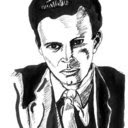In 1994, a group of scientists scrambling around in the Ardèche wilderness felt the faintest of breezes emanating from the cliff face beside them. They managed to burrow their way into a hidden limestone cave, enclosed for thousands of years, and there they made a startling and historic discovery that would ripple through the worlds of anthropology, geology, and art history: cave paintings dating back some 35,000 years. Since that date, only a handful of carefully selected scientists have been granted access to the Chauvet Caves (named after one of the original scientists); and only one man has ever been allowed in without any academic or scientific justification. Fortunately for us he had a camera with him, and his name was Werner Herzog.
Werner Herzog is a berserk and poetic filmmaker, and it is difficult to imagine anyone more suited to the frightening responsibility of recording the caves, knowing that he might be the only person ever to be granted permission to film there. Herzog doesn’t approach the task with any contrived humbleness or gravity; he approaches it like the giddy, maniacal genius that he is. He has a truly unique vision of the world, a deep care for the most archetypal and basic of human dramas, and one of the most melodic and soothing voices ever recorded.
There is no attempt to hide the clunking, equipment-ridden nature of the caves. Chrome walkways and cement doors exist not just beside but actually within this most fascinating and spiritual of monuments to human thought. As Herzog and his crew traipse along the walkways with their battery-powered lights and rustling overalls, there is a real sense of the claustrophobic ‘humanness’ of this adventure. You feel as if you are there with them, crouching and grunting and trying to avoid crossing lenses. So when they suddenly arrive at the back of the cave and stare, speechless, into the darkness, you find yourself completely unprepared for the quiet power of the paintings. You are still standing there behind Werner, in the awesome stillness of the caves, holding your breath and forgetting to blink.
The paintings are disarmingly beautiful and evocative, and they remain with you for a long time after the film has finished. Fortunately Herzog has avoided the crass temptation to turn the paintings into some dramatic story or use animation to bring them to life. Instead, he somehow transports us to the spiritual stillness of the cave; allowing the magnanimity of the images – their composure, the rippling lines on the cave walls, and the perfect shading and facial expressions on the animals – to completely absorb the viewer. They are powerful now, in the age of Avatar and Halo, so just imagine how entrancing they would have been 35,000 years ago, flickering in the firelight.
At one point, hopefully tongue-in-cheek, Herzog suggests that the pictures are “proto-cinema”. But even if this is in jest, there is certainly something in the idea of venturing into a ‘darkness’, adjusting to it, and then being bombarded by an astounding array of images while you are in an almost dreamlike state. The ritual of drama really hasn’t changed that much in 35,000 years.
It could be argued that there are Avatar fans and there are Herzog fans, and never the twain shall meet. So Herzog’s decision to use 3D technology for this project was greeted with some controversy. But Herzog fans needn’t have worried: the cameras used to shoot the film are lo-fi to say the least, and the extra dimension only causes the flickering grain and overexposure of the footage to leap out at you in an uncomfortable and shoddy way. It is a half-baked experiment with a trashy technology, thank goodness. Sometimes the 3D actually manages to peer through the darkness of the caves and add some faint and unnecessary depth to the images. But with Werner’s wonderful throaty voice expounding on the mysteries of human thought that have been unlocked by these paintings, an extra pane of depth in the camera is an awkward and silly appendage. Herzog 1 : 3D 0.






No comments :
Post a Comment